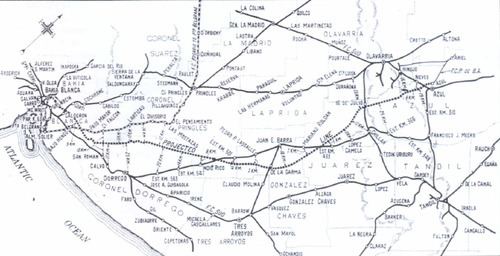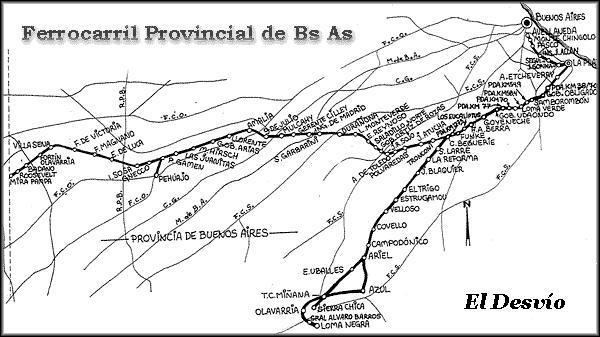Opened 1912 | ||
 | ||
Native name Ferrocarril Provincial de Buenos Aires Status Defunct company; rail line inactive Closed 1977; 40 years ago (1977) Owner Government of Buenos Aires Province | ||
The Province of Buenos Aires Railway (in Spanish: Ferrocarril Provincial de Buenos Aires - FCPBA) was a state-owned company that operated a 902 km 1,000 mm (3 ft 3 3⁄8 in) metre gauge railway network in the Province of Buenos Aires in Argentina. Founded in 1907 as the "Ferrocarril Provincial del Puerto de La Plata al Meridiano V", the company changed its name to FCPBA in 1924, in 1951 it was taken into state ownership and in 1953 it was absorbed by the state-owned Belgrano Railway. The FCPBA should not confused with the similarly named French–owned Compañía General (CGBA) which also operated in the Province.
Contents

Project

By the end of 19th Century, railway lines in Buenos Aires Province were managed by two British companies, BA Great Southern and Argentine Great Western. Both companies had the monopoly of the market, apart from fixing the rates. Therefore, the Government of Buenos Aires thought of an railway transport which could work as an efficient alternative to the British-owned ones.

In 1897, the "Law of Agriculture and Economy Railway lines" was promulgated. This Law allowed any person to build (under some legal and technical requirements) 3 ft 6 in (1,067 mm) gauge railway lines. Governor of Buenos Aires Province, Marcelino Ugarte, encouraged the construction of a regional railway line to compete against the dominant British companies. He considered that the appearance of a more economic railroad transport would make British companies to decrease the rates to keep their position in the market.

A provincial decree promulgated in September 1904 decided the construction of a railway line from Barracas al Sud to Carhué. This line was given to Buenos Aires Midland Railway in 1906. In March 1905 the other concession were given to French-owned Compañía General de Ferrocarriles en la Provincia de Buenos Aires. Both lines would be competing against Ferrocarril Provincial.
The lines to be built were determined as following:

The main offeror for the project was "Societe Anonime Franco-Argentine de travaux publics", a Franco-Belgian society headed by Otto Bemberg. The society was formed by Bemberg & Cia, Louis Dreyfus and Emili Erlanger & Cia, and Dirks & Dates.
Construction
In August 1907 authorisation was given for the construction of the line, originally named "Ferrocarril Provincial del Puerto de La Plata al Meridiano V". Construction began in La Plata in June 1909 and the sections of the line were progressively opened as follows:
This completed a 553 km line with 31 stations and on 31 August 1916 the provincial Government took over the operation of the railway. The first service run on March 17, 1912, crossing desert and infertile areas. The only important town was 9 de Julio (that was already served by the Western Railway). As time passed, new towns were established such as Loma Verde, Etcheverry, Gobernador Udaondo, Carlos Beguerie, Hirsh, Fortín Olavarría, Roosvelt and Mira Pampa. Nevertheless, the railway did not obtain profits due to floodings or poor harvests.
The original project was partially fulfilled so only the western branch was built. In 1913 other Law authorized the Government to build 4,000 km in Buenos Aires Province as an expansion of the main line. The branches to be built were the following:
Exploitation and Expansion
The railway continue its expansion during the next years, reaching more towns in Buenos Aires Province. The cities joined by the train were as follows:
On 14 November 1924 the name of the company was changed to "Ferrocarril Provincial de Buenos Aires" (abbreviated FCPBA).
In the mid-1940s the Provincial Government decided to nationalise the Ferrocarril Depietri that run from San Pedro and Arrecifes. Eduardo Depietri, owner of the line, refused to give his company but the Government revoked the concession on November 1949 alleging breach of contract and the railway was expropriated.
Nevertheless, the San Pedro-Arrecifes service would not run anymore because the FCPBA never showed interests in 68 km of pathways that were far away from its own line. The Ferrocarril Belgrano (whose tracks intersected with the Depietri's railway) nor took interest in taking over the expropriated railway. The abandoned structure was depredated and the remained assets were returned to Depietri's company in 1967. The tracks were dismantled, the lands sold and the rest was sold as scrap.
On 31 December 1951 the company was transferred to state ownership as an independent entity under the control of the Empresa Nacional de Transportes (ENT) and in 1953 was absorbed by Ferrocarril General Manuel Belgrano, one of the six state-owned companies formed after the nationalisation of the entire railway network in 1948.
On 1 January 1954 the Ferrocarril Nacional Provincia de Buenos Aires (FNPBA) was formed by integrating the FCPBA, the CGBA and the Buenos Aires Midland Railway and was incorporated into the Ferrocarril Belgrano on 7 October 1957.
Decline and Closure
The lines between Etcheverry and Mira Pampa and Carlos Beguerie to Azul and Olavarría, together with their respective branch lines, were closed on 28 October 1961 during the Government of Arturo Illia. The line between Olavarría and La Plata was re-opened temporarily for freight traffic only from April 1964 to 1968. The track between Carlos Beguerie and Mira Pampa was removed in October 1974 and the passenger service on the branch from Avellaneda to La Plata was discontinued in July 1977.
